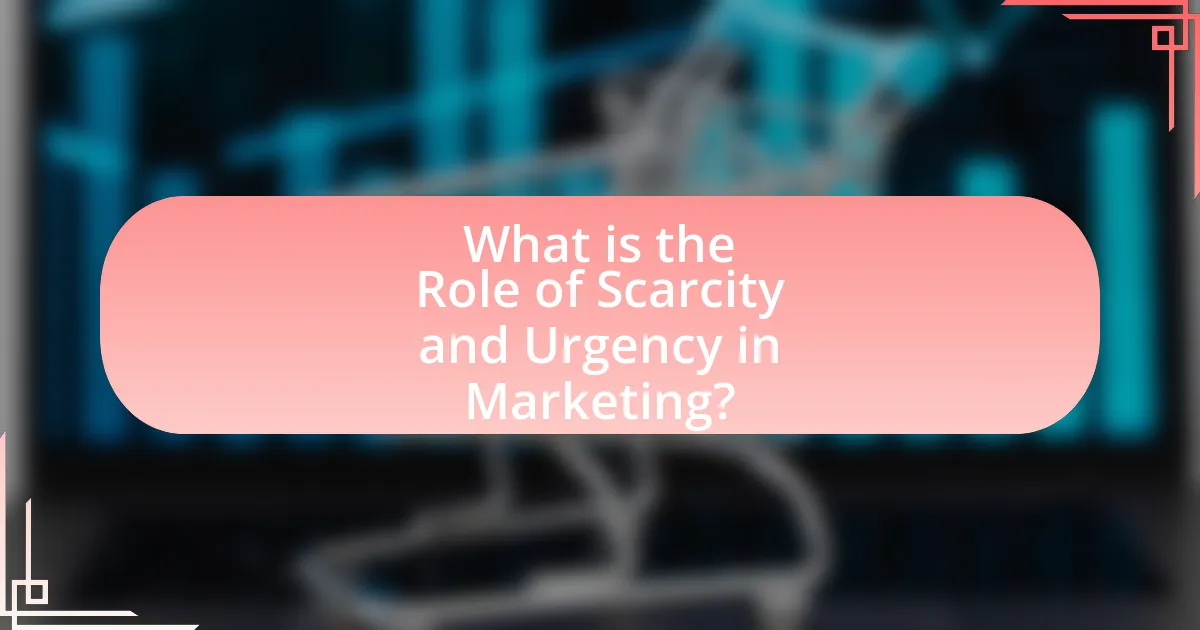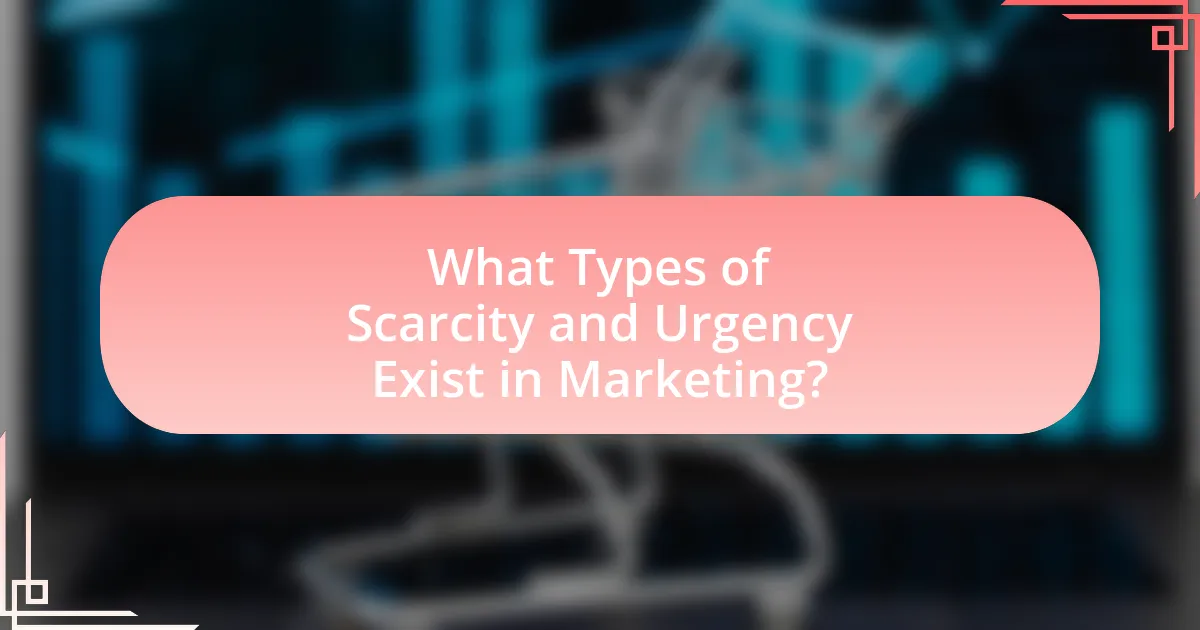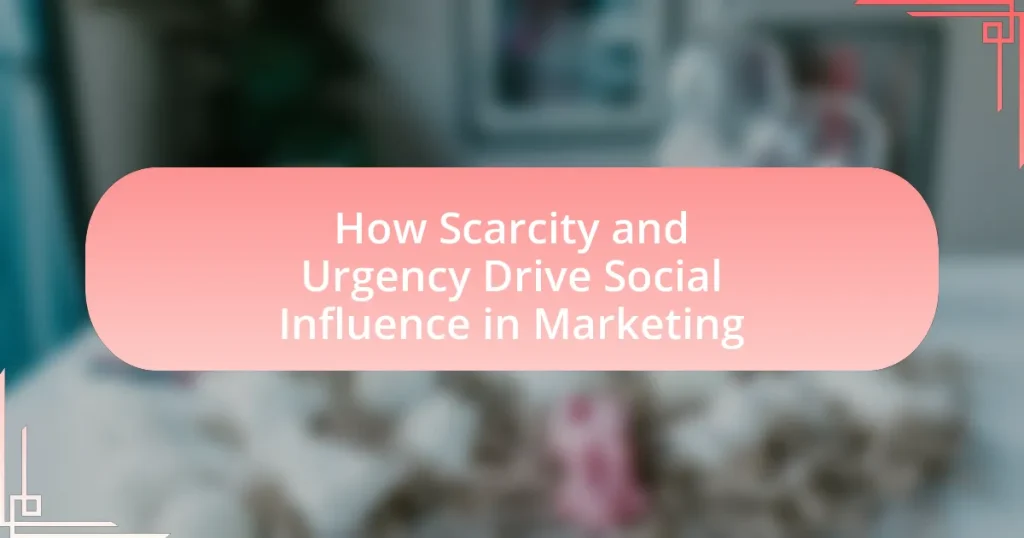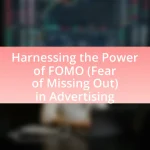Scarcity and urgency are pivotal concepts in marketing that significantly influence consumer behavior by creating perceptions of limited availability and time constraints. This article explores how these psychological triggers drive purchasing decisions, supported by research indicating that scarcity enhances perceived value while urgency compels immediate action. It examines the underlying psychological principles, the effectiveness of various scarcity and urgency strategies, and the potential pitfalls of misusing these tactics. Additionally, the article discusses practical tips for marketers to implement these strategies effectively and measure their impact on consumer engagement and sales outcomes.

What is the Role of Scarcity and Urgency in Marketing?
Scarcity and urgency play a critical role in marketing by creating a perception of limited availability and time constraints, which can drive consumer behavior. When products are presented as scarce, such as limited editions or low stock alerts, consumers are more likely to perceive them as valuable and desirable, leading to increased demand. Similarly, urgency, often communicated through time-limited offers or countdown timers, compels consumers to act quickly to avoid missing out. Research by Cialdini (2009) in “Influence: Science and Practice” supports this, indicating that scarcity increases perceived value and urgency prompts immediate action, both of which enhance the effectiveness of marketing strategies.
How do Scarcity and Urgency Influence Consumer Behavior?
Scarcity and urgency significantly influence consumer behavior by creating a perception of limited availability and time constraints, which can drive immediate purchasing decisions. When consumers perceive that a product is scarce, such as limited stock or exclusive offers, they often feel a heightened sense of desire and urgency to acquire the item before it is gone. Research by Cialdini (2009) indicates that scarcity can increase the perceived value of a product, leading to a higher likelihood of purchase. Additionally, urgency, often communicated through time-limited promotions, compels consumers to act quickly, reducing the time available for deliberation and increasing impulse buying. This phenomenon is supported by a study published in the Journal of Consumer Research, which found that consumers are more likely to purchase items when they believe they are in short supply or when a deadline is approaching.
What psychological principles underlie Scarcity and Urgency?
Scarcity and urgency are underpinned by the psychological principles of loss aversion and the scarcity principle. Loss aversion, a concept from behavioral economics, posits that individuals prefer to avoid losses rather than acquire equivalent gains, making them more likely to act when they perceive a potential loss, such as a limited-time offer. The scarcity principle suggests that people assign higher value to resources that are perceived as limited, leading to increased desire and urgency to obtain those resources. Research by Cialdini (2009) in “Influence: Science and Practice” demonstrates that limited availability can significantly enhance the perceived value of an item, prompting quicker decision-making among consumers.
How do Scarcity and Urgency create a sense of value?
Scarcity and urgency create a sense of value by triggering psychological responses that enhance perceived worth. When a product is scarce, consumers associate it with exclusivity, leading to a higher valuation of that item; for instance, a study by Cialdini (2009) highlights that limited availability increases desirability. Similarly, urgency, often communicated through time-limited offers, compels consumers to act quickly, reinforcing the notion that the opportunity is valuable and fleeting. Research indicates that urgency can lead to a 332% increase in conversion rates during promotional campaigns, demonstrating its effectiveness in driving consumer behavior.
Why are Scarcity and Urgency Effective Marketing Strategies?
Scarcity and urgency are effective marketing strategies because they create a psychological trigger that compels consumers to act quickly. When products are perceived as limited in availability or time-sensitive, consumers experience a fear of missing out, which increases their likelihood of making a purchase. Research by Cialdini (2009) highlights that scarcity enhances the perceived value of an item, making it more desirable. Additionally, a study published in the Journal of Consumer Research found that urgency can lead to increased sales by prompting immediate decision-making, as consumers are motivated to avoid the regret of missing an opportunity.
What evidence supports the effectiveness of these strategies?
Research indicates that scarcity and urgency significantly enhance consumer decision-making and purchasing behavior. A study by Cialdini et al. (2006) demonstrated that limited-time offers increase perceived value and urgency, leading to a 30% increase in sales compared to standard promotions. Additionally, a meta-analysis by Gierl and Huettl (2010) found that scarcity appeals can boost consumer desire and intention to purchase, with effects varying based on product type and consumer characteristics. These findings collectively support the effectiveness of scarcity and urgency strategies in marketing.
How do Scarcity and Urgency impact decision-making processes?
Scarcity and urgency significantly influence decision-making processes by creating a perception of limited availability and time constraints, which can lead to quicker and often less rational choices. When individuals perceive that a product or opportunity is scarce, they may experience increased desire and urgency to act, often resulting in impulse purchases. Research by Cialdini (2009) indicates that scarcity can enhance the perceived value of an item, making it more attractive to consumers. Additionally, urgency, often communicated through time-limited offers, can trigger a fear of missing out (FOMO), compelling individuals to make decisions rapidly to avoid regret. This psychological response is supported by studies showing that limited-time promotions can increase sales by up to 30%, demonstrating the powerful role of scarcity and urgency in shaping consumer behavior.

What Types of Scarcity and Urgency Exist in Marketing?
Scarcity and urgency in marketing primarily manifest as limited availability and time constraints. Limited availability refers to situations where products or services are offered in restricted quantities, creating a perception of exclusivity. For example, a brand may announce that only 100 units of a new product will be sold, prompting consumers to act quickly to secure their purchase. Time constraints involve deadlines for offers, such as flash sales or limited-time discounts, which compel consumers to make swift decisions to avoid missing out. Research indicates that these tactics effectively increase consumer demand and drive sales, as demonstrated by a study published in the Journal of Consumer Research, which found that scarcity can enhance perceived value and desirability of products.
How do Different Forms of Scarcity Affect Marketing Outcomes?
Different forms of scarcity significantly influence marketing outcomes by creating a sense of urgency that drives consumer behavior. Scarcity can be categorized into two main types: absolute scarcity, where a product is limited in quantity, and perceived scarcity, where consumers believe a product is scarce due to marketing tactics. Research indicates that products marketed as scarce can lead to increased demand; for instance, a study published in the Journal of Consumer Research found that limited-time offers can boost sales by up to 30%. This effect occurs because consumers fear missing out, prompting quicker purchasing decisions. Thus, both absolute and perceived scarcity effectively enhance marketing outcomes by leveraging psychological triggers that compel consumers to act swiftly.
What are the differences between perceived and actual scarcity?
Perceived scarcity refers to the belief or impression that a product or resource is limited, while actual scarcity is the genuine limitation of that product or resource. Perceived scarcity can be influenced by marketing tactics, such as limited-time offers or exclusive releases, which create a sense of urgency among consumers. In contrast, actual scarcity is based on real supply constraints, such as a finite number of items produced or available. Research indicates that perceived scarcity can significantly impact consumer behavior, often leading to increased demand, even when the actual supply is sufficient. For example, a study published in the Journal of Consumer Research found that consumers are more likely to purchase items labeled as “limited edition” regardless of the actual availability, demonstrating the power of perceived scarcity in driving sales.
How does time-limited urgency differ from quantity-limited scarcity?
Time-limited urgency refers to a situation where a product or offer is available for a limited time, creating pressure to act quickly, while quantity-limited scarcity involves a limited number of items available, prompting consumers to act before the items run out. Time-limited urgency often leverages countdowns or deadlines to enhance the sense of immediacy, as seen in flash sales that last only a few hours. In contrast, quantity-limited scarcity emphasizes the finite nature of the product itself, such as limited edition releases, which can lead to increased demand due to the fear of missing out on a rare item. Both concepts drive consumer behavior, but they do so through different mechanisms: urgency through time constraints and scarcity through limited availability.
What are Common Examples of Scarcity and Urgency in Marketing?
Common examples of scarcity and urgency in marketing include limited-time offers, exclusive product releases, and low-stock notifications. Limited-time offers create urgency by encouraging consumers to act quickly to take advantage of a deal, often resulting in increased sales. Exclusive product releases, such as a new sneaker line available only to a select group, leverage scarcity by making the product feel more desirable due to its limited availability. Low-stock notifications, like “Only 2 left in stock,” instill a sense of urgency, prompting consumers to purchase before the item sells out. These strategies are effective because they tap into the psychological principles of loss aversion and the fear of missing out, driving consumer behavior towards quicker purchasing decisions.
How do flash sales utilize urgency to drive sales?
Flash sales utilize urgency to drive sales by creating a limited-time offer that compels consumers to act quickly. This sense of urgency triggers a fear of missing out (FOMO), which can significantly increase conversion rates. Research indicates that consumers are more likely to make impulsive purchases when they perceive a time constraint; for instance, a study published in the Journal of Consumer Research found that limited-time promotions can enhance the perceived value of a product, leading to a 30% increase in sales during flash sales events. By emphasizing the short duration of the offer, retailers effectively motivate customers to prioritize their purchase decisions, thereby boosting overall sales.
What role does limited edition products play in creating scarcity?
Limited edition products create scarcity by intentionally restricting availability, which heightens consumer demand. This strategy leverages the psychological principle of scarcity, where consumers perceive limited availability as more valuable. Research indicates that scarcity can increase desirability; for instance, a study published in the Journal of Consumer Research found that consumers are more likely to purchase items perceived as scarce due to the fear of missing out. By offering limited edition products, brands effectively stimulate urgency and enhance their appeal, driving sales and fostering a sense of exclusivity among consumers.

How Can Marketers Effectively Implement Scarcity and Urgency?
Marketers can effectively implement scarcity and urgency by creating limited-time offers and highlighting the exclusivity of products. For instance, using phrases like “only 5 left in stock” or “sale ends in 24 hours” triggers a psychological response that encourages immediate action. Research indicates that scarcity can increase perceived value; a study published in the Journal of Consumer Research found that consumers are more likely to desire products that are less available. Additionally, urgency can be reinforced through countdown timers on websites, which visually emphasize the limited time available to make a purchase, further motivating consumers to act quickly.
What Best Practices Should Marketers Follow When Using Scarcity?
Marketers should create genuine scarcity by limiting product availability and clearly communicating this limitation to consumers. This practice enhances perceived value and urgency, driving quicker purchasing decisions. For instance, a study by Cialdini (2009) highlights that limited-time offers can significantly increase consumer interest and sales, as people are motivated to act quickly to avoid missing out. Additionally, marketers should ensure that the scarcity is authentic; misleading consumers can damage brand trust and lead to negative backlash.
How can marketers ensure authenticity in their scarcity claims?
Marketers can ensure authenticity in their scarcity claims by providing verifiable evidence of limited availability. This can be achieved through transparent communication about stock levels, such as displaying real-time inventory counts or using timestamps for promotional offers. Research indicates that consumers are more likely to trust scarcity claims when they are backed by factual data; for instance, a study published in the Journal of Consumer Research found that consumers respond positively to scarcity messages that include specific numbers or percentages regarding limited stock. By aligning their messaging with actual inventory and maintaining honesty in their promotions, marketers can build credibility and foster trust with their audience.
What are the potential pitfalls of misusing Scarcity and Urgency?
Misusing scarcity and urgency can lead to customer distrust and brand damage. When marketers create artificial scarcity or urgency, consumers may feel manipulated, resulting in negative perceptions of the brand. Research indicates that 70% of consumers are more likely to distrust a brand that employs deceptive marketing tactics, which can lead to decreased customer loyalty and increased churn rates. Additionally, overuse of these tactics can desensitize consumers, making them less responsive to future marketing efforts. This phenomenon is supported by studies showing that repeated exposure to false urgency can diminish its effectiveness, ultimately harming sales rather than boosting them.
How Can Brands Measure the Impact of Scarcity and Urgency?
Brands can measure the impact of scarcity and urgency through various metrics such as conversion rates, customer engagement levels, and sales data during limited-time offers. By analyzing these metrics, brands can assess how scarcity tactics, like limited stock notifications, and urgency strategies, such as countdown timers, influence consumer behavior. For instance, a study by Cialdini et al. (2006) demonstrated that perceived scarcity increases desirability, leading to higher purchase rates. Additionally, A/B testing can provide concrete evidence of how different scarcity and urgency messages affect customer actions, allowing brands to refine their strategies based on real-time data.
What metrics are useful for evaluating the effectiveness of these strategies?
Key metrics for evaluating the effectiveness of scarcity and urgency strategies in marketing include conversion rates, customer engagement levels, and return on investment (ROI). Conversion rates measure the percentage of visitors who complete a desired action, indicating how well scarcity or urgency prompts purchases. Customer engagement levels, assessed through metrics like click-through rates and time spent on site, reflect how effectively these strategies capture attention and drive interaction. ROI quantifies the financial return generated from marketing efforts, providing insight into the overall impact of scarcity and urgency tactics on profitability. These metrics collectively offer a comprehensive view of strategy effectiveness, supported by data that links increased urgency and perceived scarcity to higher consumer action and sales.
How can A/B testing be used to assess Scarcity and Urgency tactics?
A/B testing can be used to assess Scarcity and Urgency tactics by comparing two variations of a marketing message or offer, one featuring scarcity or urgency elements and the other without. This method allows marketers to measure the impact of these tactics on consumer behavior, such as conversion rates and purchase decisions. For instance, a study by Cialdini et al. (2006) demonstrated that limited-time offers significantly increased sales compared to standard offers, providing empirical evidence that urgency can drive consumer action. By analyzing the performance metrics from the A/B test, marketers can determine the effectiveness of scarcity and urgency in influencing customer behavior and optimize their strategies accordingly.
What Practical Tips Can Marketers Use to Leverage Scarcity and Urgency?
Marketers can leverage scarcity and urgency by implementing limited-time offers, exclusive deals, and countdown timers. Limited-time offers create a sense of urgency, prompting consumers to act quickly to avoid missing out. For instance, a study by Cialdini (2009) highlights that consumers are more likely to purchase when they perceive an item as scarce, as it triggers a fear of loss. Exclusive deals, such as members-only sales, enhance the feeling of scarcity by making products available to a select group, increasing their perceived value. Countdown timers on websites or emails can visually reinforce urgency, encouraging immediate action. Research indicates that urgency can increase conversion rates by up to 332% when effectively communicated.


